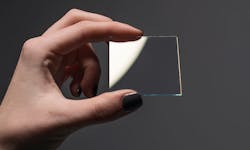A team led by Robert W. Boyd, professor of optics and physics at the University of Rochester (Rochester, NY) and the Canada Excellence Research Chair in Quantum Nonlinear Optics at the University of Ottawa (Ottawa, ON, Canada), has demonstrated that the transparent, electrical conductor indium tin oxide (ITO) can result in up to 100 times greater nonlinearity than other known materials. The researchers says that the greater the nonlinearity, the more promising the material for real-life applications.
RELATED ARTICLE: Nonlinear crystal does supernarrow-linewidth frequency conversion
"This result is a game-changer for photonics applications," said Boyd. "It rests on the core of what I've worked on for over 30 years at Rochester. I find it very rewarding that even after all this time there are still fundamental questions to be answered in the field of nonlinear optics." The research was published online by the journal Science.
A key aspect to being able to exert control over light is to be able to control a specific property—the refractive index—of the material that is transmitting the light. When the refractive index is different for different light intensities, the material is described as being optically nonlinear. The refractive index of the material is changed for only a few femtoseconds and for some potential applications, it is possible to send a second pulse through the material before it has time to recover for the first pulse. This second pulse then "sees" the material as having the refractive index as modified by the first pulse.
In general though, it is the quickness with which the material recovers as well as the range of values that the refractive index can take—how strongly nonlinear the material is--that makes this system particularly attractive to photonics applications.
Boyd, his PhD student at Ottawa, M. Zahirul Alam, and then-research associate Israel De Leon were able to improve on the previous record for optical nonlinearities by a factor of 100. This improvement took place because these researchers exploited the unusual optical properties of a material that occurs under certain conditions, what is known as the epsilon-near-zero region.
"It was surprising that showing such a strong optical nonlinearity in a known metal was this easy," said Boyd. "This material has been around for many years, but until now the community had overlooked the potential that the 'epsilon-near-zero' region of materials offered."
"The optical nonlinear response that we have observed introduces a new paradigm in nonlinear optics," said De Leon, now a professor at Tecnologico de Monterrey, Mexico. "The common knowledge had always been that nonlinear effects are tiny compared with the linear ones; but in our work we have measured a nonlinear response that is 170% larger than the linear response."
The 'epsilon-near-zero' region for this material is linked to light of a specific frequency, roughly a wavelength of 1.2 microns. This wavelength is of interest because it is in between that of visible light and light of wavelength 1.5 microns and is of particular interest to optical communications. It is possible that changes in the chemical composition of the material could lead to a change in the frequency at which epsilon near zero occurs, thus bringing this frequency closer to that used by optical communications applications.
SOURCE: University of Rochester; http://www.rochester.edu/newscenter/researchers-demonstrate-record-optical-nonlinearity-157732/

Gail Overton | Senior Editor (2004-2020)
Gail has more than 30 years of engineering, marketing, product management, and editorial experience in the photonics and optical communications industry. Before joining the staff at Laser Focus World in 2004, she held many product management and product marketing roles in the fiber-optics industry, most notably at Hughes (El Segundo, CA), GTE Labs (Waltham, MA), Corning (Corning, NY), Photon Kinetics (Beaverton, OR), and Newport Corporation (Irvine, CA). During her marketing career, Gail published articles in WDM Solutions and Sensors magazine and traveled internationally to conduct product and sales training. Gail received her BS degree in physics, with an emphasis in optics, from San Diego State University in San Diego, CA in May 1986.
